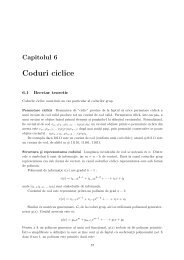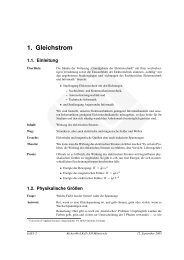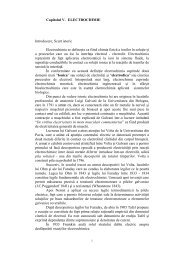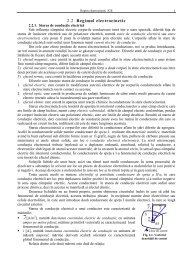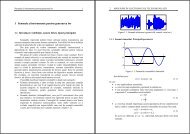Retele Locale de Calculatoare RLC - derivat
Retele Locale de Calculatoare RLC - derivat
Retele Locale de Calculatoare RLC - derivat
Create successful ePaper yourself
Turn your PDF publications into a flip-book with our unique Google optimized e-Paper software.
<strong>Retele</strong> <strong>Locale</strong> <strong>de</strong> <strong>Calculatoare</strong><br />
Nicolae Tapus<br />
ntapus@cs.pub.ro<br />
Sala EF304<br />
<strong>RLC</strong><br />
site-ul cursului este<br />
http://curs.cs.pub.ro
References<br />
Behrouz A Forouzan<br />
Data Communications and Networking<br />
McGraw Hill<br />
http://highered.mcgrawhill.com/sites/0072515848/stu<strong>de</strong>nt_view0/<br />
William Stallinks<br />
Data and Computer Communication<br />
Pearson Prentice Hall<br />
Andrew Tanenbaum<br />
<strong>Retele</strong> <strong>de</strong> <strong>Calculatoare</strong><br />
Byblos
Overview of<br />
Data Communications<br />
and<br />
Networking
Simplified Communications Mo<strong>de</strong>l-Diagram
A Communications Mo<strong>de</strong>l<br />
Source<br />
generates data to be transmitted<br />
Transmitter<br />
Converts data into transmittable signals<br />
Transmission System<br />
Carries data<br />
Receiver<br />
Converts received signal into data<br />
Destination<br />
Takes incoming data
Five components of data communication<br />
A message to be communicated.<br />
This message may be data, text, audio, graphics, or vi<strong>de</strong>o.<br />
A <strong>de</strong>vice that sends the message.<br />
This <strong>de</strong>vice could be a computer mainframe, a computer<br />
workstation, a telephone, or any other <strong>de</strong>vice that transmits<br />
data.<br />
A <strong>de</strong>vice that receives the message.<br />
This <strong>de</strong>vice could also be a computer mainframe, a computer<br />
workstation, a telephone, or any other <strong>de</strong>vice that receives<br />
data.<br />
A medium over which to transmit the message.<br />
This medium may be a physical path for the message such as<br />
some type of cable or a radiated electromagnetic signal such<br />
as radio waves.<br />
A protocol for transmitting the message.<br />
A protocol is a set of rules prescribing how to perform<br />
something. In data communications, a protocol is a set of<br />
rules <strong>de</strong>termining how the message will be transmitted.
Simplified Data Communications Mo<strong>de</strong>l
Several terms that are often used<br />
A line is a physical connection between two<br />
points in a network.<br />
A circuit can be a single or multiple<br />
connection or a nonphysical connection such<br />
as a satellite or microwave transmission.<br />
A link is an unbroken circuit between two<br />
network no<strong>de</strong>s.<br />
A channel is either a whole circuit or part of<br />
a circuit.
Basic Concepts<br />
The five basic concepts that <strong>de</strong>scribe<br />
the relationships between<br />
communicating <strong>de</strong>vices are:<br />
transmission mo<strong>de</strong><br />
line configuration<br />
topology<br />
types of networks<br />
internetworks
Transmission Mo<strong>de</strong><br />
The three types of data transmission<br />
simplex,<br />
half-duplex, and<br />
full-duplex
Simplex<br />
Simplex data transmission: data can flow only in one direction
Half-duplex<br />
Half-duplex data transmission: data can flow in both directions, but<br />
only in one direction at a time.
Full-duplex<br />
Full-duplex data transmission: data can flow in both directions at<br />
the same time.
Line configurations<br />
Line configurations <strong>de</strong>scribe the way<br />
<strong>de</strong>vices are connected.<br />
There are two configurations:<br />
(1) point-to-point configuration and<br />
(2) multipoint, or multidrop, configuration.
Line Configuration (1): Point-to-point connection<br />
In the point-to-point configuration, the link is <strong>de</strong>dicated to<br />
communications between two <strong>de</strong>vices.
Line Configuration (2): Multipoint connection<br />
In the multipoint configuration, the link is shared by multiple terminals.
Categories of topology
Fully connected mesh topology (for five <strong>de</strong>vices)<br />
In mesh topology, every no<strong>de</strong> is connected by a <strong>de</strong>dicated point-to-point<br />
connection to all other no<strong>de</strong>s. A message will require only one hop no<br />
matter where the sending and receiving no<strong>de</strong>s are located in the network.<br />
Number of connections = T × (T – 1)/2<br />
where T = the number of no<strong>de</strong>s or terminals.
Star topology<br />
In the star topology, the central no<strong>de</strong> is connected to every other no<strong>de</strong>.<br />
Messages between two no<strong>de</strong>s, where neither is the central no<strong>de</strong>, always<br />
require two hops.
Bus topology<br />
In the bus topology, a cable running the length of the network<br />
connects all no<strong>de</strong>s or workstations with a multipoint connection.<br />
The small solid rectangles at each end represent the cable ends. A<br />
message from no<strong>de</strong> A to no<strong>de</strong> B is put onto the bus and is received<br />
by all no<strong>de</strong>s on the bus, including no<strong>de</strong> B.
Ring topology<br />
In the ring topology, a closed loop connects all of the workstations.<br />
Messages from A to B flow through the intervening no<strong>de</strong>s, in sequence,<br />
until they reach B. In our diagram, four hops are required if the traffic<br />
flows only in the counterclockwise direction.<br />
B<br />
A
Categories of networks<br />
Local area networks (LANs), wi<strong>de</strong> area networks (WANs), and metropolitan area<br />
networks (MANs) are the primary categories of networks.<br />
In addition to these three categories, hybrid networks are created using internetworking<br />
<strong>de</strong>vices. Hybrid networks often combine the best characteristics of pure LAN, WAN, or<br />
MAN networks. LANs, WANs, and MANs differ in the way they are used and in the<br />
technologies
LAN- Local Area Network<br />
LANs connects microcomputers and other workstation <strong>de</strong>vices located in<br />
a single office, a single building, or on a campus.<br />
The use of LANs allowed the sharing of resources, including hardware,<br />
software, and data.<br />
LAN characteristics inclu<strong>de</strong>:<br />
•a common transmission medium throughout the network<br />
•bus, ring, or star topologies<br />
•lengths of less than 10 km<br />
•usually owned by their users<br />
•typical data rates of 10 Mbps (Megabits per second) , 100 Mbps,<br />
1Gbps and 10 Gbps systems in <strong>de</strong>velopment
LAN (Continued)
MAN – Metropolitan Area Network<br />
MANs, the newest of the three network types, span geographical areas that usually<br />
encompass a city or county and use digital technology similar to that used in<br />
LANs. MANs are often used to connect a series of LANs. Because of the larger<br />
area covered, MANs are usually owned by a public carrier or local government<br />
agency.<br />
MANs may also be used as a backbone network to interconnect distributed LANs.
WAN- Wi<strong>de</strong> Area Networks<br />
WANs are centrally monitored and managed networks used to interconnect users<br />
over large geographical areas that may span cities, states, or countries.<br />
A public carrier owns the communication circuits for most WANs. This makes sense<br />
for all but the largest corporations, because of the cost involved in establishing and<br />
maintaining the circuits over long distances.<br />
When a single company owns a WAN, it is often called an enterprise network.
Internetworks<br />
It is often <strong>de</strong>sirable to connect networks.<br />
The following terms are used to <strong>de</strong>scribe<br />
these types of connections:<br />
An internet or internetwork is the<br />
connection of two or more networks.<br />
The Internet is the worldwi<strong>de</strong> network we<br />
all use.<br />
An intranet is a private network that uses<br />
Internet technologies.<br />
The <strong>de</strong>vices used for network<br />
interconnections inclu<strong>de</strong> bridges, routers, and<br />
gateways.
Internet today<br />
NAP- Network Access Point<br />
ISP – Internet Services Provi<strong>de</strong>r
1837<br />
Significant Events in Data Communications<br />
Invention of the telegraph.<br />
History<br />
Samuel Morse invented the telegraph. By using a series of dots<br />
and dashes, people were able to send messages over long<br />
distances using telegraph wires.<br />
1876<br />
Invention of the telephone.<br />
Antonio Meuci (Alexan<strong>de</strong>r Graham Bell) invented the telephone. It<br />
allowed people to talk to each other over telephone lines.<br />
1885<br />
AT&T incorporated.<br />
By 1983, American Telephone and Telegraph (AT&T) controlled 90<br />
percent of our nation's telephones and owned companies that<br />
provi<strong>de</strong>d most of the end-to-end telephone service (Fitzgerald<br />
1993, 272). Because of its size and importance, AT&T was<br />
regulated by the FCC.
1937<br />
Significant Events in Data Communications<br />
History<br />
ARINC case.<br />
The FCC granted Aeronautical Radio Inc. (ARINC) permission,<br />
over the objections of AT&T, to provi<strong>de</strong> a communications<br />
network for the airline industry.<br />
1940<br />
Bell Labs succee<strong>de</strong>d in data communication experiment.<br />
One of the first attempts to attach computer-related <strong>de</strong>vices to<br />
communication <strong>de</strong>vices occurred when Bell Labs (an AT&T<br />
company) at Dartmouth College communicated with an<br />
electronic calculator in New York City.<br />
1956<br />
Hush-a-Phone case.<br />
Hush-a-Phone <strong>de</strong>veloped a rubber shield that could be placed<br />
over the telephone mouthpiece to provi<strong>de</strong> privacy in a crow<strong>de</strong>d<br />
room. AT&T sued to halt the sale of these <strong>de</strong>vices and won, but<br />
then lost on an appeal. AT&T was concerned that any foreign<br />
attachment to its network could affect performance and strongly<br />
discouraged such attachments.
Significant Events in Data Communications<br />
History<br />
1964<br />
Rand Corporation introduced the concept of packet-switching<br />
networks.<br />
The Arpanet was based on the concept of packet-switching<br />
networks, as was later the Internet.<br />
1969<br />
MCI case.<br />
MCI (then known as Microwave Communications, Inc.) asked the<br />
FCC for approval to build a microwave service between St. Louis and<br />
Chicago, which implied that the local phone companies would<br />
provi<strong>de</strong> local connectivity for users. AT&T conten<strong>de</strong>d that doing so<br />
would:<br />
fragment the nation's communications because of differing standards<br />
and interface problems<br />
construct duplicate systems the country didn't need<br />
cause "cream skimming" of the best customers<br />
MCI won a landmark <strong>de</strong>cision that broke AT&T's monopoly of leased<br />
lines and required AT&T to provi<strong>de</strong> local connections.
Significant Events in Data Communications<br />
1969<br />
History<br />
Arpanet implemented.<br />
The Arpanet, a network fun<strong>de</strong>d by the U.S.<br />
Department of Defense's Advanced Research Projects<br />
Agency (ARPA), was implemented with four no<strong>de</strong>s.<br />
Arpanet was the forerunner of the Internet.<br />
1971<br />
University of Hawaii <strong>de</strong>veloped Alohanet.<br />
The University of Hawaii <strong>de</strong>veloped the Alohanet, a<br />
radio network used to transmit data packets in the<br />
Hawaiian Islands. This network was the inspiration for<br />
Ethernet, which we will discuss in module 3.<br />
1973<br />
Xerox <strong>de</strong>veloped Ethernet.
Conception of the Ethernet
Significant Events in Data Communications<br />
History<br />
1989<br />
World Wi<strong>de</strong> Web introduced.<br />
The World Wi<strong>de</strong> Web (WWW) was created,<br />
leading to a commercialization of the Internet.<br />
1998<br />
Ericsson introduces Bluetooth wireless<br />
communications.<br />
Bluetooth provi<strong>de</strong>s short-range data<br />
communications for local area networks (LANs)<br />
and other computer-related equipment.



